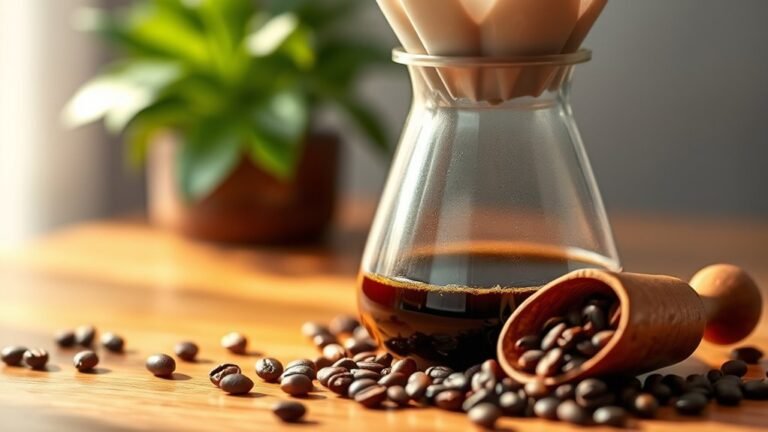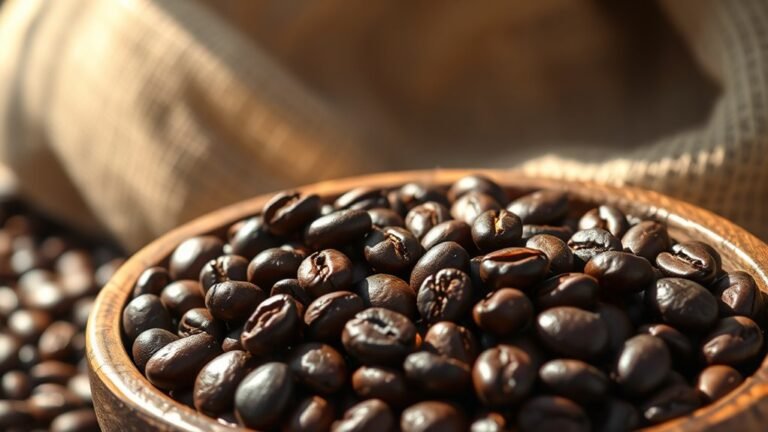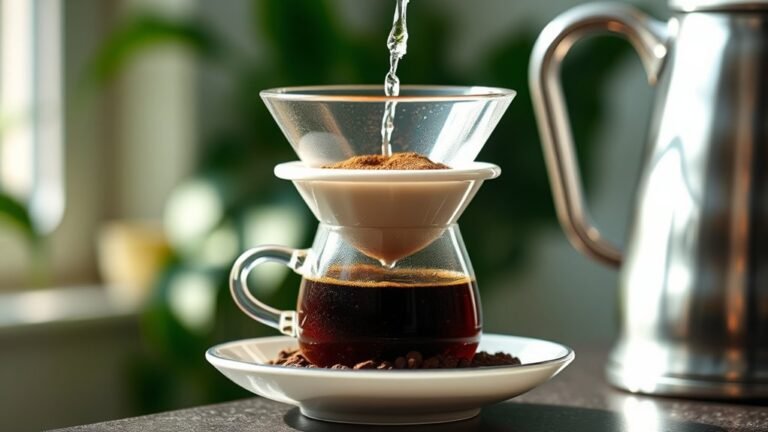The Best Time to Grind Your Coffee Beans
You want to grind your coffee beans just before brewing to capture the fullest aroma and richest flavor. Once ground, coffee’s essential oils start evaporating quickly, and exposure to oxygen dulls the taste within minutes. Grinding too early leads to a flat, less vibrant cup. Matching grind size to your brewing method also enhances the experience. If you’re aiming for the best brew, understanding the timing and technique behind grinding will really elevate your coffee game.
Why Freshly Ground Coffee Matters

Although pre-ground coffee might seem convenient, freshly ground coffee beans are crucial for revealing the full spectrum of flavors and aromas in your cup. When you grind just before brewing, you control freshness factors that directly impact the complexity of your coffee’s taste profiles. Ground coffee quickly loses volatile oils and aromatic compounds essential for a vibrant, rich experience. By grinding fresh, you reveal nuanced notes—whether fruity, nutty, or chocolaty—that pre-ground coffee simply can’t deliver. If you value your freedom to explore and enjoy coffee’s true character, grinding on demand is non-negotiable. It’s not just about convenience; it’s about honoring the coffee’s potential and savoring every dimension of flavor that fresh grinding preserves. Your brew deserves nothing less.
How Oxidation Affects Coffee Flavor
Because oxygen interacts aggressively with the delicate compounds in coffee, understanding oxidation is key to preserving your brew’s flavor. When coffee beans are ground, their increased surface area accelerates oxidation effects, leading to rapid flavor deterioration. You want to avoid losing those vibrant notes and aromas that make your coffee unique. Here’s how oxidation impacts your coffee:
- Exposure to air breaks down essential oils, dulling flavor intensity.
- Aromatic compounds evaporate quickly, reducing aroma complexity.
- Oxidation speeds up staling, making your coffee taste flat and bitter.
- Prolonged exposure can cause rancidity, ruining the cup’s balance.
Ideal Timeframe for Grinding Beans
You’ll want to grind your coffee beans just before brewing to lock in maximum freshness and flavor. The longer ground beans sit, the more they lose aroma and taste due to oxidation. Grinding fresh guarantees every cup bursts with the rich, vibrant notes you’re aiming for.
Grinding Before Brewing
Grinding your coffee beans within minutes before brewing is one of the most effective ways to maximize freshness and flavor. When you grind just before brewing, you reveal the beans’ full aromatic potential, preserving essential oils that start to dissipate soon after grinding. To truly savor your coffee’s complexity, you need to master precise grinding techniques and select the right grind sizes for your brewing method. Here’s why timing matters:
- Retains volatile aromatics, enhancing taste.
- Allows immediate extraction of flavors.
- Prevents oxidation and staling.
- Gives you control over grind sizes, matching your preferred brewing process.
Storage Time Impact
Although freshly ground coffee delivers the best flavor, knowing how long you can store ground beans without significant quality loss is essential for convenience and consistency. Typically, ground coffee begins to lose its vibrant taste within 15 to 30 minutes of exposure to air, but this timeframe can be extended depending on your storage conditions. If you keep your grounds in an airtight container, away from light, heat, and moisture, you can preserve much of the bean variety’s unique characteristics for up to a week. However, the more delicate and complex the bean variety, the faster its flavor compounds degrade once ground. To truly enjoy freedom in your coffee routine, balance grinding ahead with ideal storage to maintain flavor without sacrificing your schedule.
Grind Freshness Benefits
To truly appreciate the complex flavors coffee beans offer, grinding them just before brewing makes all the difference. When you grind fresh, you maintain ideal grind consistency, which directly impacts brew quality. Here’s why timing your grind matters:
- Preserves Aroma: Freshly ground beans release volatile oils that vanish quickly after grinding.
- Enhances Flavor: Grinding right before brewing locks in nuanced taste notes otherwise lost over time.
- Improves Extraction: Consistent grind size guarantees even water contact, preventing under- or over-extraction.
- Maximizes Control: You can adjust grind fineness to suit brewing method and personal preference on the spot.
Grinding fresh liberates the full potential of your coffee, giving you freedom to savor every distinct, vibrant sip. Don’t settle for stale grounds—embrace freshness as your brewing ally.
Grinding Beans for Different Brewing Methods

When you tailor your grind size to the brewing method, you release the full potential of your coffee’s flavor. Each brewing method demands a specific grind size to optimize extraction and highlight unique taste profiles. Grinding too coarse or too fine can lead to under- or over-extraction, masking your coffee’s true character. Embrace the freedom to experiment but start with this guide to match grind size to brewing method perfectly:
| Brewing Method | Recommended Grind Size | Flavor Impact |
|---|---|---|
| French Press | Coarse | Rich, full-bodied |
| Drip Coffee | Medium | Balanced, smooth |
| Espresso | Fine | Intense, concentrated |
| AeroPress | Medium-Fine | Bright, versatile |
| Cold Brew | Extra Coarse | Mellow, less acidic |
Adjusting grind size empowers you to craft your perfect cup.
Impact of Storage on Ground Coffee
Since ground coffee has a much larger surface area exposed to air compared to whole beans, it loses freshness and flavor more rapidly. If you want to savor every note in your brew, understanding the impact of storage on ground coffee is essential. Proper storage conditions can make or break your cup’s quality. Here’s what you need to know:
- Use airtight containers to minimize oxygen exposure, preserving aromatic oils.
- Store in a cool, dark place away from heat and sunlight to prevent flavor degradation.
- Avoid moisture; even slight humidity can cause grounds to clump and spoil.
- Only buy or grind what you’ll consume within a week—freshness fades fast.
Tips for Grinding Coffee at Home
Although grinding coffee at home might seem straightforward, mastering the process is key to releasing your beans’ full potential. First, choose the right grinding technique for your brewing method; blade grinders offer quick results but lack uniform coffee consistency, while burr grinders provide precise, even grounds essential for balanced flavor. Always grind just before brewing to preserve freshness and aroma. Pay attention to grind size—too coarse or too fine can disrupt extraction, so adjust accordingly. Consistency in your grind guarantees each cup delivers the freedom of rich, nuanced taste you crave. Finally, invest in a quality grinder that fits your lifestyle. With these tips, you’ll elevate your coffee ritual, savoring every moment and sip with confidence and control.
Common Mistakes When Grinding Coffee

Mastering the grind is essential, yet many coffee enthusiasts unknowingly make mistakes that compromise flavor. If you want full control over your brew, avoid these common pitfalls:
- Ignoring grinding consistency: Uneven grounds lead to over- or under-extraction, dulling your coffee’s true character.
- Using the wrong grind size: Each brewing method demands a specific grind size; using the wrong one limits your freedom to craft perfect coffee.
- Grinding too far in advance: Ground coffee quickly loses aroma and flavor; grinding just before brewing preserves freshness.
- Overloading the grinder: Too many beans cause uneven grinding, reducing quality and control.
Equipment Choices for Grinding Beans
Choosing the right grinder is one of the most critical decisions you’ll make for your coffee routine. Blade grinders are budget-friendly but sacrifice grind consistency, making them less ideal for precise brewing. Burr grinders, available in manual and electric versions, offer superior grind size control and uniformity, essential for releasing your beans’ full potential. Manual grinders grant freedom from electricity and often deliver excellent consistency, perfect for adventurers. Electric grinders provide speed and convenience but vary widely in price, so a careful price comparison is key. Regardless of your choice, regular maintenance tips like cleaning burrs and removing residue guarantee your grinder performs at its best. Your equipment choice dictates how freely you can explore grind settings and elevate your coffee experience.
Grinding Coffee for Maximum Aroma
You want to grind your coffee beans just before brewing to lock in that vibrant aroma and preserve essential oils. Waiting too long after grinding lets those delicate flavors escape, dulling the cup’s richness. Timing your grind is vital—it directly shapes the flavor experience you’ll enjoy.
Timing for Freshness
Although grinding your coffee beans ahead of time might seem convenient, it greatly diminishes the freshness and aroma you can enjoy in your cup. Grind timing is essential because freshness factors like oxygen, moisture, and heat begin breaking down your coffee’s essential oils the moment you grind. To savor the fullest aroma, you should grind just before brewing. Here’s what to keep in mind:
- Grind immediately before brewing to lock in freshness.
- Store whole beans properly to delay staling.
- Avoid grinding for more than a few minutes in advance.
- Consider grind size’s interaction with timing for ideal extraction.
Impact on Flavor
Since coffee’s complex flavors are tightly bound within its oils and compounds, grinding plays an essential role in releasing its full aromatic potential. When you grind your beans just before brewing, you reveal the richest flavor complexity, allowing subtle notes to shine through. Delaying grinding diminishes aroma intensity as volatile oils evaporate, leaving a flat, less vibrant cup. By controlling grind size and timing, you preserve essential compounds that define your coffee’s character. Grinding too early sacrifices freshness; too coarse or fine alters extraction, impacting taste. Embracing the freedom to grind immediately means you savor every nuanced layer and vibrant scent your beans offer. Ultimately, the impact on flavor hinges on your commitment to timing—grind smart, and your coffee rewards you with unmatched aroma and depth.
Balancing Convenience With Freshness
When aiming to enjoy the freshest cup possible, grinding your coffee beans just before brewing is ideal, yet this approach can sometimes clash with the fast pace of daily routines. You need to balance convenience factors with freshness priorities to fit your lifestyle without sacrificing flavor. Here’s how you can strike that balance:
- Grind only the amount you need for each brew to maximize freshness.
- Use a high-quality grinder that operates quickly and quietly.
- Consider grinding the night before if mornings are rushed, storing grounds in an airtight container.
- Experiment with partial grinding—grind coarse beans in advance, then finish grinding fresh before brewing.
Frequently Asked Questions
Can Grinding Coffee Beans Affect Caffeine Content?
You might think grinding coffee beans changes caffeine content, but it actually doesn’t alter how much caffeine’s in there. What matters is caffeine extraction, which depends on grind uniformity and brewing time. When your grind’s consistent, extraction’s even, letting you enjoy the full caffeine kick and flavor freedom you crave. So focus on getting a uniform grind—you’ll reveal your coffee’s true potential without losing any caffeine along the way.
Does Bean Origin Impact Grinding Time?
Yes, bean origin can impact grinding time because different bean varieties have unique densities and moisture levels. When you grind, you’ll notice that some beans need a bit more time to achieve the perfect grind consistency. Understanding these subtle differences lets you tailor your grind, revealing the fullest flavor potential. Embracing this freedom means you’re not just brewing coffee—you’re crafting an experience that’s uniquely yours.
How Does Humidity Influence Grinding Results?
Humidity effects can seriously impact your grinding consistency. When moisture is high, your beans may clump together, causing uneven particle sizes and affecting extraction. You’ll notice slower grinding and inconsistent results. To maintain freedom in your brewing, you might adjust grind settings or store beans in airtight containers to combat humidity’s influence. Understanding these subtle shifts empowers you to achieve the perfect grind, no matter the weather.
Should I Adjust Grind Size for Espresso Tamping?
Imagine tuning a guitar; if your strings are too tight or loose, the sound’s off. Similarly, you should adjust your grind size when tamping espresso to achieve ideal grind consistency. A finer grind increases resistance, balancing tamp pressure and enhancing espresso extraction. If your espresso tastes sour or bitter, tweak your grind size slightly. This precision lets you access the full flavor, giving you the freedom to craft your perfect shot every time.
Can Pre-Ground Coffee Be Re-Ground Safely?
You might wonder about re-ground safety when considering pre-ground coffee, but it’s not ideal. Re-grinding can over-extract bitterness and ruin coffee freshness, compromising flavor and aroma. You lose control over grind consistency, which impacts your brew’s quality. For the freedom to enjoy vibrant, fresh coffee, it’s better to grind just before brewing. This way, you guarantee a satisfying, flavorful cup every time without risking stale or uneven grounds.






